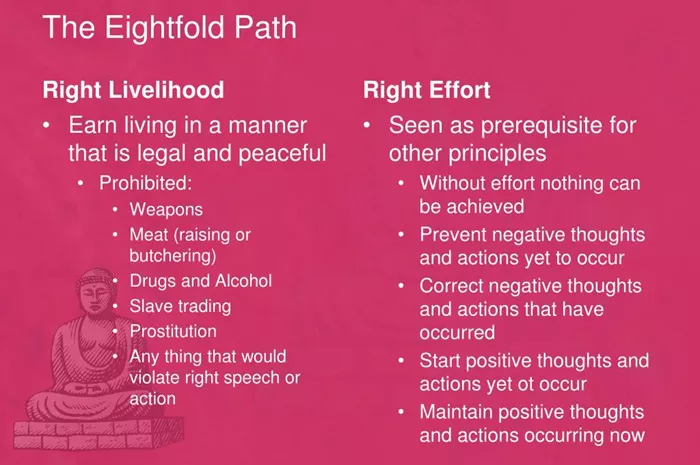The Eightfold Path is one of the most important teachings in Buddhism. It is a guide for people who want to end suffering and reach enlightenment. The Buddha taught this path after he became enlightened. It is part of the Four Noble Truths, which explain the nature of suffering and how to overcome it. This article will explore whether the Buddha really taught the Eightfold Path and explain each step in simple words.
What Is the Eightfold Path?
The Eightfold Path is a set of eight practices that help people live a good life and find inner peace. It is also known as the “Middle Way” because it avoids extreme lifestyles. The Buddha taught that people should not live in luxury or practice extreme self-denial. Instead, they should follow a balanced way of life.
The Eightfold Path includes:
Right View (Understanding)
Right Intention (Thinking)
Right Speech (Speaking)
Right Action (Acting)
Right Livelihood (Working)
Right Effort (Striving)
Right Mindfulness (Awareness)
Right Concentration (Meditation)
These steps are grouped into three main sections: wisdom, ethical conduct, and mental discipline.
Did Buddha Teach the Eightfold Path?
Yes, the Buddha taught the Eightfold Path as a way to end suffering. According to Buddhist scriptures, he discovered this path after years of meditation and self-reflection. After reaching enlightenment, he gave his first sermon at Deer Park in Sarnath, India. This sermon is called the Dhammacakkappavattana Sutta, which means “The Setting in Motion of the Wheel of Dharma.” In this teaching, the Buddha explained the Four Noble Truths and introduced the Eightfold Path.
The Buddha emphasized that the Eightfold Path is not a set of strict rules but a way of living. He encouraged people to practice these steps in daily life. He also said that following the path requires patience and effort.
The Three Parts of the Eightfold Path
The Eightfold Path is divided into three main sections: wisdom, ethical conduct, and mental discipline. Each section helps a person develop different qualities.
1. Wisdom (Prajna)
Wisdom includes Right View and Right Intention. This section helps people understand life and develop a good attitude.
Right View means seeing life as it really is. It involves understanding the Four Noble Truths and knowing that everything changes.
Right Intention means thinking in a kind and unselfish way. It includes having good thoughts and avoiding harmful desires.
2. Ethical Conduct (Sila)
Ethical conduct includes Right Speech, Right Action, and Right Livelihood. These steps help people live a moral life.
Right Speech means speaking truthfully and kindly. It includes avoiding lies, harsh words, and gossip.
Right Action means behaving in a way that does not harm others. It includes not killing, stealing, or engaging in harmful activities.
Right Livelihood means choosing a job that is honest and does not cause harm. The Buddha advised against jobs that involve weapons, killing, or cheating.
3. Mental Discipline (Samadhi)
Mental discipline includes Right Effort, Right Mindfulness, and Right Concentration. These steps help people train their minds.
Right Effort means making a continuous effort to improve oneself. It includes avoiding negative thoughts and developing good qualities.
Right Mindfulness means being aware of the present moment. It involves paying attention to thoughts, feelings, and actions.
Right Concentration means practicing meditation to develop a calm and focused mind.
The Eightfold Path and the Middle Way
The Buddha often spoke about the “Middle Way.” This means avoiding extremes, such as too much pleasure or too much suffering. The Eightfold Path is an example of the Middle Way. It helps people live a balanced and meaningful life.
Before he became enlightened, the Buddha lived in two extreme ways. First, he lived as a prince with great luxury. Then, he became an ascetic and practiced severe self-denial. He realized that neither extreme led to true happiness. Instead, he found the Middle Way, which became the foundation of the Eightfold Path.
How to Practice the Eightfold Path in Daily Life
Practicing the Eightfold Path is not about following strict rules. Instead, it is about making small, meaningful changes in daily life.
Learn about Right View – Read and reflect on the Four Noble Truths.
Develop Right Intention – Think kindly and avoid negative thoughts.
Practice Right Speech – Speak with kindness and honesty.
Follow Right Action – Treat others with respect and avoid harm.
Choose Right Livelihood – Work in a way that benefits others.
Make Right Effort – Keep improving yourself and avoid bad habits.
Be Mindful – Pay attention to your thoughts and actions.
Meditate – Practice concentration and calmness through meditation.
Even small efforts can bring positive changes. The Buddha taught that progress happens step by step.
Why Is the Eightfold Path Important?
The Eightfold Path is important because it provides a clear way to end suffering. It helps people understand themselves and the world. It also teaches them how to live peacefully with others. Many Buddhists follow this path to reach enlightenment, but it is also useful for anyone who wants a more meaningful life.
The Eightfold Path is not just for monks or spiritual people. It can be practiced by anyone, regardless of religion or background. It helps people develop wisdom, kindness, and inner peace.
Conclusion
The Buddha did teach the Eightfold Path. It is a guide to living a good and meaningful life. It helps people overcome suffering and reach enlightenment. The path is based on wisdom, ethical conduct, and mental discipline. The Buddha’s teachings show that anyone can follow this path, no matter their background. By practicing these steps, people can find peace and happiness in everyday life.
The Eightfold Path remains an important part of Buddhism today. It continues to inspire millions of people around the world. Whether someone is a Buddhist or not, these teachings can bring great benefits to life.

